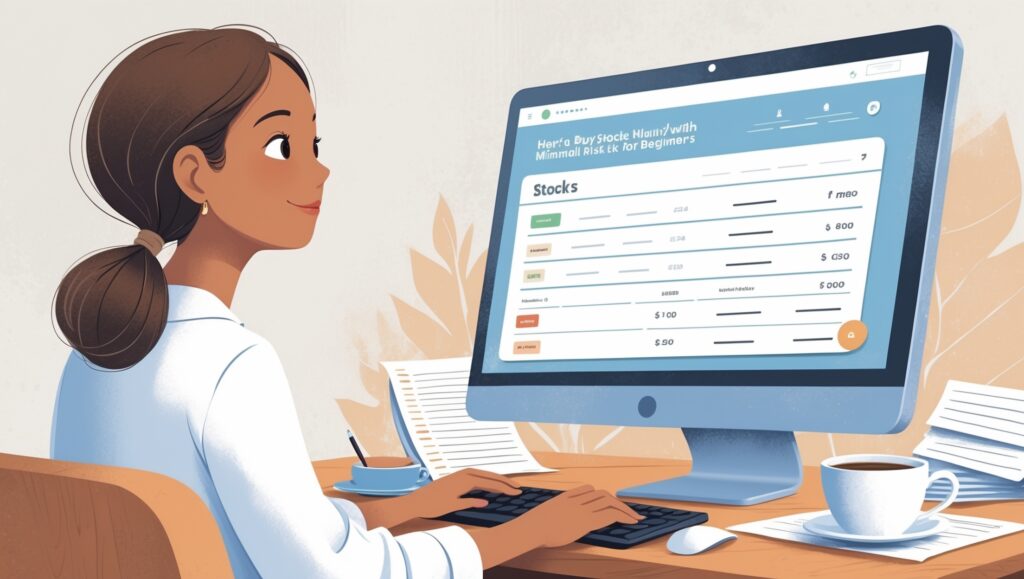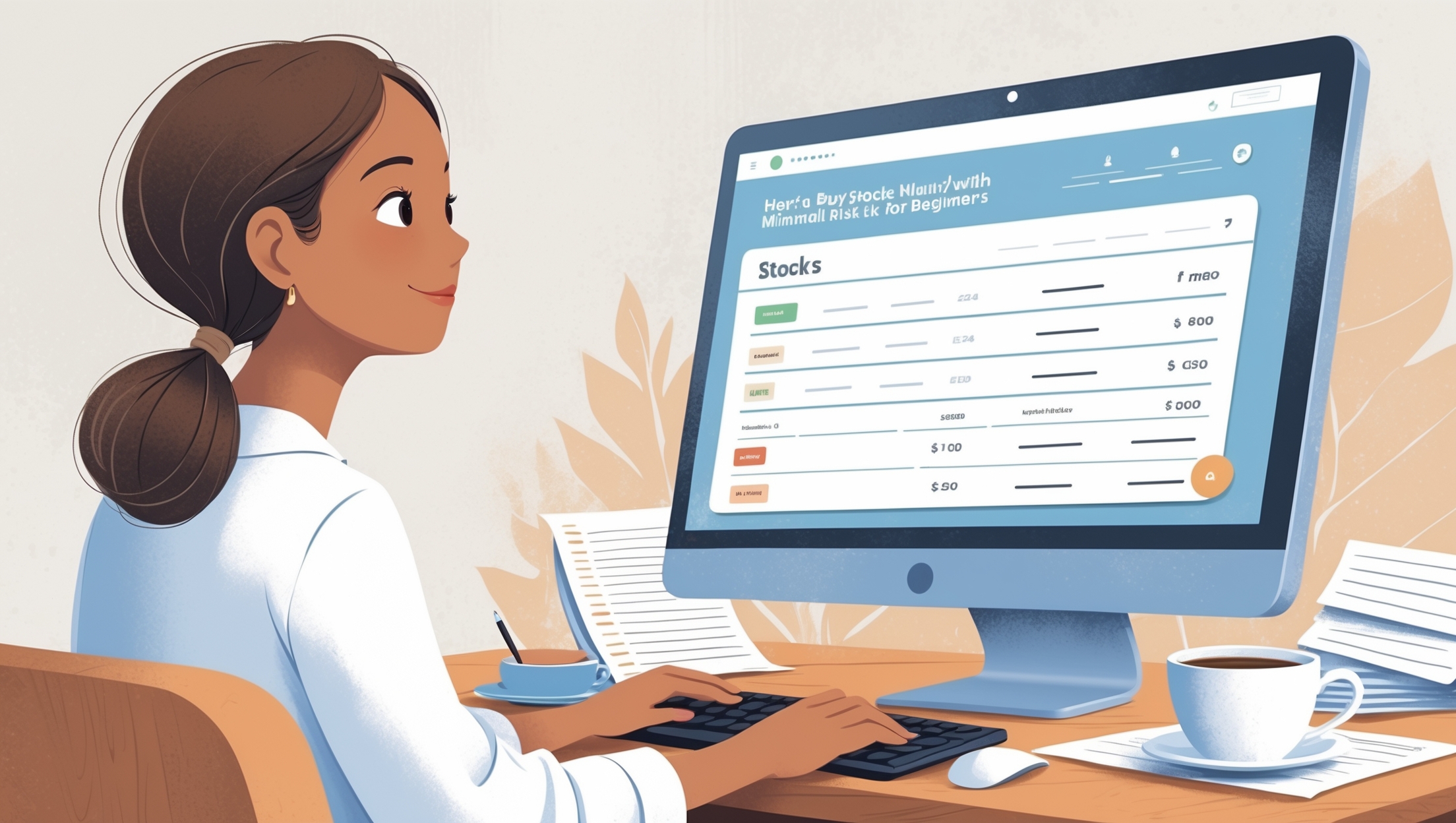How to Buy Stocks with Minimal Risk for Beginners
How to Buy Stocks with Minimal Risk for Beginners
Looking for the safest way to start investing? Learn how to buy stocks with minimal risk as a beginner, the strategies I personally use to protect my money, and the tools that make the process easier.

Table of Contents
When I first started investing in stocks, my biggest fear was losing money. I didn’t come from a wealthy background, and every dollar I put into the market mattered. If you’re new, you probably feel the same. The good news is that you don’t need to gamble or take reckless risks to start investing. There are safe, beginner-friendly ways to build wealth over time while minimizing risk.
In this guide, I’ll walk you through the exact strategies I use to buy stocks with confidence, even when markets are unpredictable. I’ll also share tools and resources that helped me, including my own ebook on paying bills with stocks, which goes deeper into my personal investing journey.
Focus on Education Before Action
The first way to reduce risk is to learn before you leap. When I made my very first purchase, I didn’t just click “buy” because someone online told me to. I took the time to understand what the company did, how it made money, and whether it had a solid future.
Education gives you confidence, and confidence reduces risk. That’s why I always recommend beginners spend at least a few days exploring stock market basics. A free way to do this is by using platforms like TradingView, where you can practice analyzing stocks without risking real money.
Start Small and Grow Slowly
One of the most effective ways I reduced risk in the beginning was by starting small. Instead of putting thousands into one stock, I started with as little as $50. This way, if I made a mistake, it wouldn’t crush me financially.
Apps like Robinhood and Webull make this easy by allowing fractional shares. You don’t need $500 to buy a stock like Tesla—you can start with just a few dollars.
Diversify to Protect Yourself
The phrase “don’t put all your eggs in one basket” applies perfectly to investing. I learned this the hard way when I invested too much in a single stock early on. Now, I spread my investments across multiple companies and industries.
Diversification is the simplest way to buy stocks with minimal risk, and it’s a strategy even the best investors in the world use.
Use Dollar-Cost Averaging
This strategy changed everything for me. Instead of trying to time the market (which usually led to bad decisions), I set up a schedule to invest the same amount of money each week. Sometimes I bought at higher prices, sometimes lower, but over time, it averaged out.
Dollar-cost averaging takes the pressure off. You don’t have to predict the market—you just have to be consistent.
Stick With Stable, Reliable Companies
When you’re a beginner, it’s tempting to chase “hot” stocks you see on social media. I did that once, and let’s just say it didn’t end well. What worked better for me was focusing on companies with strong financials and a history of growth.
Think of companies that have been around for decades and have proven they can survive economic ups and downs. They may not skyrocket overnight, but they offer stability and lower risk.
Never Invest What You Can’t Afford to Lose
This is the golden rule I live by. I don’t put my rent money, grocery money, or emergency savings into the stock market. Instead, I only invest money that I can set aside for the long term.
By doing this, I protect myself from panic selling and avoid financial stress.
Tools That Make Risk Management Easier
- TradingView – My go-to for tracking and analyzing stocks.
- Robinhood – Perfect for beginners to start small with fractional shares.
- Webull – Great for free stocks when you sign up and useful research tools.
I’ve personally used these platforms to grow my portfolio safely without feeling overwhelmed.
Final Thoughts
Buying stocks with minimal risk is possible if you stay disciplined. For me, the keys were education, starting small, diversifying, and being patient. I didn’t get rich overnight, but I built a foundation for financial freedom that continues to grow.
If you want a deeper dive into how I manage my portfolio and even use stocks to pay bills, I share my personal blueprint in my ebook here. It’s beginner-friendly, practical, and built from real experience—not theory.
When I think back to my early days of investing, I realize that fear was actually a good thing. That fear kept me cautious, which helped me avoid taking reckless risks. Over time, I learned that it’s not about avoiding all risk—it’s about managing it wisely.
One of the habits that helped me most was keeping an investing journal. I wrote down why I bought a stock, what I expected to happen, and how I felt about it. Later, when I looked back, I could see patterns in my decisions and improve my strategy.
I also learned that patience is the ultimate tool for minimizing risk. If I rushed into trades, I often lost money. But when I gave investments time to grow, I saw much better results. The stock market rewards long-term thinking more than quick moves.
Another lesson was understanding the power of compounding. Even if I started small, reinvesting dividends and holding onto quality stocks created a snowball effect over time. What seemed like small gains eventually added up to something powerful.
For me, risk management also meant setting realistic expectations. I stopped believing I could double my money overnight and instead focused on steady, consistent growth. That mindset shift reduced stress and helped me avoid emotional mistakes.
Having an emergency fund outside the stock market gave me peace of mind. I knew that if something unexpected happened, I wouldn’t be forced to sell my investments at a loss. This safety net made me a more confident investor.
I also realized that I didn’t need to follow every trend or hype stock. By staying grounded and focusing on my own financial goals, I avoided getting caught up in “fear of missing out.” That alone saved me from costly mistakes.
Learning basic technical analysis gave me another layer of confidence. Simple things like recognizing support and resistance levels or reading moving averages helped me spot safer entry points. Tools like TradingView made this much easier.
I found that talking with other investors—whether online or in person—opened my eyes to strategies I hadn’t considered. Community support gave me reassurance, but I still made sure to do my own research before making decisions.
Another smart move was setting automatic stop-loss orders on certain trades. This way, if a stock fell too far, I wouldn’t lose more than I was comfortable with. It was like having a safety belt for my portfolio.
I started by focusing on industries I actually understood. For example, I knew more about technology and consumer goods than healthcare or banking. Sticking with what I understood minimized confusion and improved my confidence.
Risk also dropped when I stopped checking my portfolio every five minutes. Constantly watching prices only made me anxious and tempted me to sell too soon. Instead, I shifted to checking weekly or monthly, which kept me calmer and more focused.
I learned to celebrate small wins. Even a 5% or 10% gain was something worth appreciating, especially as a beginner. By focusing on progress instead of perfection, I stayed motivated without taking unnecessary risks.
Reinvesting the free stocks I earned from platforms like Robinhood and Webull gave me a little bonus boost. It felt like free money, and putting it back into my portfolio accelerated my growth.
Finally, I remind myself every day that the stock market is a tool, not a lottery. If I treat it with respect, take time to learn, and apply strategies to minimize risk, it rewards me with steady growth and financial freedom over time.

Stay ahead in the stock market! Subscribe to our newsletter and receive exclusive stock flow reports, trading insights, and actionable tips directly in your inbox. Join thousands of traders who get our updates first.







